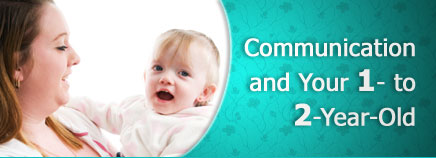
Language development really takes off during this time, especially as your little one approaches the second birthday.
Kids this age are better able to comprehend what is said to them and express what they want through words and gestures. They take joy in their ability to understand directions — and won’t hesitate to give directions of their own.
How Toddlers Communicate
Most kids say their first words around the time of their first birthday. A toddler who is preoccupied with learning to walk may push talking to the back burner; it’s not unusual and is nothing to be alarmed about.
Kids this age might have learned fragments of dozens of words that may not be recognizable. They may echo what they hear or mix a few words with jargon (babbling with sentence-like intonations). When they get around to talking, though, they’ll probably progress quickly and soon be able to point at something familiar and say its name, and recognize names of familiar people, objects, and body parts.
By 2 years old, most toddlers will say 50 words or more, use phrases, and be able to put together two- to three-word sentences.
No matter when they say their first words, it’s a sure bet they are already understanding much of what is said to them before that. Your child should be able to respond to simple commands (“Roll the ball to Mommy”) and should be fully aware of the names of familiar objects and family members.
How to Encourage Language Development
Your little one is listening to everything you say and storing it away at an incredible rate. Instead of using “baby” words, use the correct names for people, places, and things. Speak slowly and clearly, and keep it simple.
Your 1-year-old might still be communicating with gestures such as pointing at pictures or at something he or she wants. Gestures will get more elaborate over this year as toddlers use them to imitate actions, express themselves, and play.
Gestures are an important part of language development. Make the connection between gestures and language by using a running commentary such as, “Do you want a drink?” (when your child points to the refrigerator), then wait for a response. Then say, “What do you want? Milk? OK, let’s get some milk.” Such behavior encourages kids to respond and participate in conversations.
Your child will probably enjoy gesture games, like pat-a-cake and so-big, and identifying things, such as body parts, pictures, or objects, and familiar people: “Where’s your ear?”, “Show me the ball” and “Where is Mommy?”
Your child’s vocabulary will grow quickly, but pronunciation isn’t likely to keep pace. By 2 years of age, most kids are understandable only about half the time. But emphasize the correct pronunciations in your responses.
Should I Be Concerned?
Most children meet these language milestones during this period:
- saying several words by 15-18 months of age
- pointing to familiar people, objects, and some body parts by 18 months
- saying 50 or more words by 2 years of age
- putting two words together to form a sentence by age 2
- following two-step commands by age 2
Don’t hesitate to report any concerns you have to your doctor, especially if you feel your child is not talking or you have concerns about hearing.
Some parents worry that a toddler who is not speaking may have autism. Children with autism and related conditions may have delayed speech or other problems with communication, but poor social interactions and limited or restricted interests or patterns of behavior are also hallmarks of the disorder.
If you have any questions or concerns about your child’s development, talk with your doctor.

